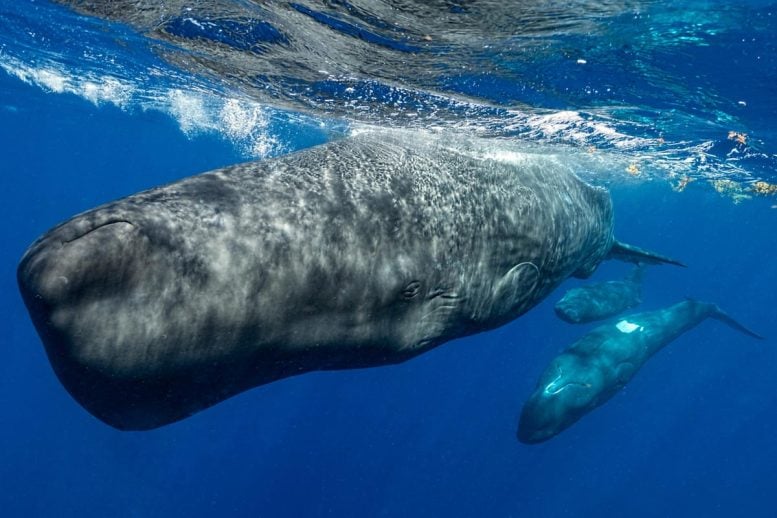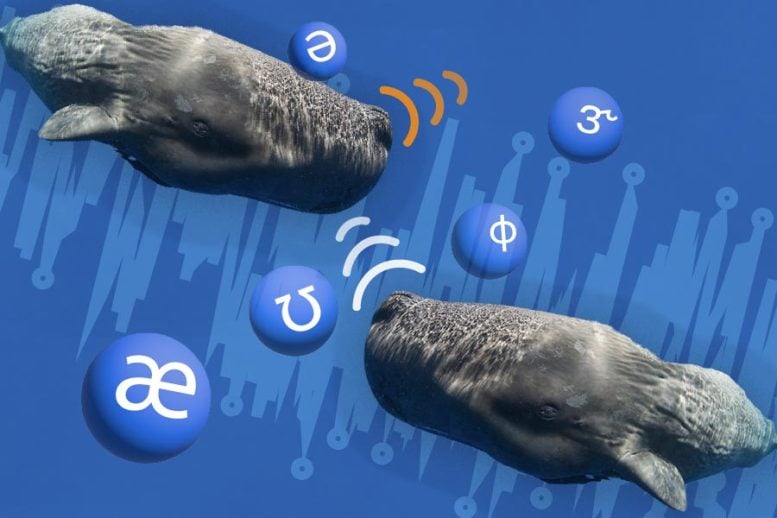
Using machine learning, MIT CSAIL and Project CETI researchers revealed complex, language-like structure in sperm whale communication with context-sensitive and combinatorial elements. Credit: Amanda Cotton
Researchers from MIT’s CSAIL and Project CETI use machine learning to decode the “sperm whale phonetic alphabet,” revealing complex communication patterns, deepening our understanding of animal language systems.
This research, which analyzed thousands of codas from Caribbean sperm whales, reveals a sophisticated, structured communication system, challenging the notion that complex communication is unique to humans. This work not only advances our understanding of marine biology but also contributes to broader conservation efforts and parallels studies of alien communication.
Whales in Myth and Science
The allure of whales has stoked human consciousness for millennia, casting these ocean giants as enigmatic residents of the deep seas. From the biblical Leviathan to Herman Melville’s formidable Moby Dick, whales have been central to mythologies and folklore. And while cetology, or whale science, has improved our knowledge of these marine mammals in the past century in particular, studying whales has remained a formidable a challenge.
Now, thanks to machine learning, we’re a little closer to understanding these gentle giants. Researchers from the MIT Computer Science and Artificial Intelligence Laboratory (CSAIL) and Project CETI (Cetacean Translation Initiative) recently used algorithms to decode the “sperm whale phonetic alphabet,” revealing sophisticated structures in sperm whale communication akin to human phonetics and communication systems in other animal species.
Discovering Sperm Whale Communication
In a new open-access study published recently in the journal Nature Communications, the research shows that sperm whale codas, or short bursts of clicks that they use to communicate, vary significantly in structure depending on the conversational context, revealing a communication system far more intricate than previously understood.
The Secret Language of Sperm Whales, Decoded. Credit: MIT CSAIL
Nine thousand codas, collected from Eastern Caribbean sperm whale families observed by the Dominica Sperm Whale Project, proved an instrumental starting point in uncovering the creatures’ complex communication system. Alongside the data gold mine, the team used a mix of algorithms for pattern recognition and classification, as well as on-body recording equipment. It turned out that sperm whale communications were indeed not random or simplistic, but rather structured in a complex, combinatorial manner.
Insights From Acoustic Tagging
The researchers identified something of a “sperm whale phonetic alphabet,” where various elements that researchers call “rhythm,” “tempo,” “rubato,” and “ornamentation” interplay to form a vast array of distinguishable codas. For example, the whales would systematically modulate certain aspects of their codas based on the conversational context, such as smoothly varying the duration of the calls — rubato — or adding extra ornamental clicks. But even more remarkably, they found that the basic building blocks of these codas could be combined in a combinatorial fashion, allowing the whales to construct a vast repertoire of distinct vocalizations.
The experiments were conducted using acoustic bio-logging tags (specifically something called “D-tags”) deployed on whales from the Eastern Caribbean clan. These tags captured the intricate details of the whales’ vocal patterns. By developing new visualization and data analysis techniques, the CSAIL researchers found that individual sperm whales could emit various coda patterns in long exchanges, not just repeats of the same coda. These patterns, they say, are nuanced, and include fine-grained variations that other whales also produce and recognize.

“Our findings indicate the presence of structured information content and also challenges the prevailing belief among many linguists that complex communication is unique to humans,” says Daniela Rus. “Our next steps aim to decipher the meaning behind these communications and explore the societal-level correlations between what is being said and group actions.” Credit: Alex Shipps/MIT CSAIL
The Significance of Whale Communication
“We are venturing into the unknown, to decipher the mysteries of sperm whale communication without any pre-existing ground truth data,” says Daniela Rus, CSAIL director and professor of electrical engineering and computer science (EECS) at MIT. “Using machine learning is important for identifying the features of their communications and predicting what they say next.
“Our findings indicate the presence of structured information content and also challenge the prevailing belief among many linguists that complex communication is unique to humans. This is a step toward showing that other species have levels of communication complexity that have not been identified so far, deeply connected to behavior. Our next steps aim to decipher the meaning behind these communications and explore the societal-level correlations between what is being said and group actions.”
Whaling Around
Sperm whales have the largest brains among all known animals. This is accompanied by very complex social behaviors between families and cultural groups, necessitating strong communication for coordination, especially in pressurized environments like deep sea hunting.
Whales owe much to Roger Payne, former Project CETI advisor, whale biologist, conservationist, and MacArthur Fellow who was a major figure in elucidating their musical careers. In the noted 1971 Science article “Songs of Humpback Whales,” Payne documented how whales can sing. His work later catalyzed the “Save the Whales” movement, a successful and timely conservation initiative.
“Roger’s research highlights the impact science can have on society. His finding that whales sing led to the marine mammal protection act and helped save several whale species from extinction. This interdisciplinary research now brings us one step closer to knowing what sperm whales are saying,” says David Gruber, lead and founder of Project CETI and distinguished professor of biology at the City University of New York.
Today, CETI’s upcoming research aims to discern whether elements like rhythm, tempo, ornamentation, and rubato carry specific communicative intents, potentially providing insights into the “duality of patterning” — a linguistic phenomenon where simple elements combine to convey complex meanings previously thought unique to human language.
Aliens Among Us
“One of the intriguing aspects of our research is that it parallels the hypothetical scenario of contacting alien species. It’s about understanding a species with a completely different environment and communication protocols, where their interactions are distinctly different from human norms,” says Pratyusha Sharma, an MIT PhD student in EECS, CSAIL affiliate, and the study’s lead author. “We’re exploring how to interpret the basic units of meaning in their communication. This isn’t just about teaching animals a subset of human language, but decoding a naturally evolved communication system within their unique biological and environmental constraints. Essentially, our work could lay the groundwork for deciphering how an ‘alien civilization’ might communicate, providing insights into creating algorithms or systems to understand entirely unfamiliar forms of communication.”
“Many animal species have repertoires of several distinct signals, but we are only beginning to uncover the extent to which they combine these signals to create new messages,” says Robert Seyfarth, a University of Pennsylvania professor emeritus of psychology who was not involved in the research.
“Scientists are particularly interested in whether signal combinations vary according to the social or ecological context in which they are given, and the extent to which signal combinations follow discernible ‘rules’ that are recognized by listeners. The problem is particularly challenging in the case of marine mammals, because scientists usually cannot see their subjects or identify in complete detail the context of communication. Nonetheless, this paper offers new, tantalizing details of call combinations and the rules that underlie them in sperm whales.”
Reference: “Contextual and combinatorial structure in sperm whale vocalisations” by Pratyusha Sharma, Shane Gero, Roger Payne, David F. Gruber, Daniela Rus, Antonio Torralba and Jacob Andreas, 7 May 2024, Nature Communications.
DOI: 10.1038/s41467-024-47221-8
Joining Sharma, Rus, and Gruber are two others from MIT, both CSAIL principal investigators and professors in EECS: Jacob Andreas and Antonio Torralba. They join Shane Gero, biology lead at CETI, founder of the Dominica Sperm Whale Project, and scientist-in residence at Carleton University. The paper was funded by Project CETI via Dalio Philanthropies and Ocean X, Sea Grape Foundation, Rosamund Zander/Hansjorg Wyss, and Chris Anderson/Jacqueline Novogratz through The Audacious Project: a collaborative funding initiative housed at TED, with further support from the J.H. and E.V. Wade Fund at MIT.









This is absolutely fascinating! As a linguist my first thought is to list likely vocabulary appropriate to whales, like seabed, turbulence, location, cries for help, food sources and so on. This is such a positive application for AI! Similar reverse interpretations are necessary for communication with prospective aliens, and with other animals.
So, does the whale’s codas or vocals change as water destiny and salinity changes? Sound does change with pressure and with a change in salinity. I would assume that clicks is a much simpler way of communicating across pressure and salinity changes. As AI accounted for those variations in the ocean?
Waste of money and time .
This user is an undercover orca whale spouting porpoise supremacy talking points, media literacy is important
This research is absolutely amazing, and needs to continue on a much larger scale.
“combined in a combinatorial fashion”
That is just poor writing.
Super interesante,
Toman en cuenta larga memoria en la interpretación
Cuánto duran las conversaciones largas1sigma
Sentimientos u objetos
The amount of redundancy in this article just to make it longer and serve you more ads… Source blocked.
When you can make a certain sound and or click and the whale turns to come greet you, that’s impressive…
Free Willy
Just Imagine if we could communicate with whales in a meaningful and mutually beneficial way. Not just strapping fricken laser beams on their heads….